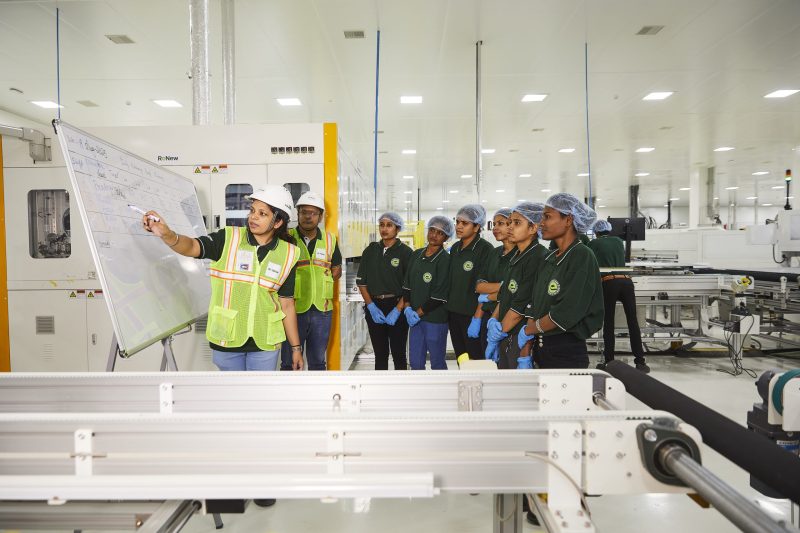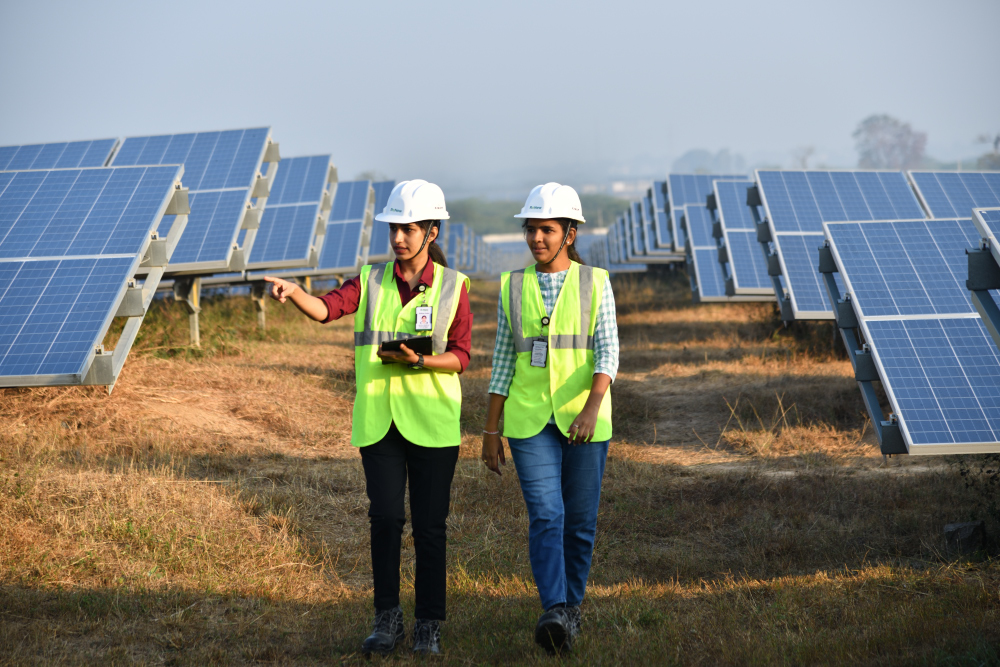Vaishali Nigam Sinha is co-founder and chairperson for sustainability at ReNew, a leading Indian provider of decarbonisation solutions.
India has emerged as a renewable energy superpower in the Global South in recent years, with record auctioning of nearly 70 gigawatts taking place in the last financial year. This rapid expansion is set to continue, with new capacity additions expected to double by 2026, surpassing the pace of many major economies.
The recently announced Union Budget from the Indian government further accelerates the country’s energy transition, with strong support for clean tech manufacturing. It sets a target of 10,000 fellowships, including research positions in India, to lead in sustainable energy.
Additionally, the focus on women’s empowerment – whether through expanded credit schemes for women entrepreneurs or enhanced participation in economic activities – demonstrates a commitment to inclusive growth.
Ambitious renewable energy targets demand a skilled workforce, but there remains work to do, with only 10% of our youth currently receiving formal or informal training for emerging green jobs, meaning we are facing a significant “green skills gap”. If left unattended, this gap threatens to impede progress toward climate goals. By improving women’s representation in India’s green workforce, we can bridge this gap, whilst ensuring the energy transition is just and inclusive.
Women behind in clean energy roles
Demand for green jobs is soaring globally, particularly in sectors such as renewable energy, waste management, energy efficiency, and climate adaptation. The International Renewable Energy Agency predicts that the global renewable energy sector will require a workforce of 38 million by 2030, more than triple the 12 million employed in 2020.
In India, the renewables sector currently employs 1.02 million people, with the potential to add 3.4 million new jobs by 2030 – but the current skills deficit could hinder India’s ability to meet its climate and clean energy commitments.
Weak gender focus at COP29 risks leaving women behind in greener future
While challenging, this context presents a huge opportunity to redress gender disparity in India’s workforce. Looking specifically at the renewable energy sector, women make up an average of 32% of the global workforce, but the proportion is significantly lower in India, at 11%. This gap is even starker when we examine women involved in roles such as operations and commissioning: women make up only around 1% of the workforce in operations and maintenance, and less than 3% in construction and commissioning.
The existing gender gap is reflective of broader structural inequalities that have historically limited women’s participation in the energy and technology industries. If these trends persist, India’s energy transition risks excluding a substantial portion of its population from its burgeoning green sector.
Ensuring a just transition
Women’s inclusion in the green economy is essential for creating a just and sustainable transition. Diverse workforces are proven to foster innovation and drive better business outcomes. Women’s participation in the energy transition can bring new perspectives and solutions to the complex challenges of climate change.
At ReNew, we are focusing on building a clean energy system that benefits all. Through our work, we are ensuring access to affordable clean energy in remote areas while reducing carbon emissions and promoting the socio-economic empowerment of women and children.
ReNew’s Project Surya, developed in collaboration with UNEP and SEWA, is training up to 1,000 women working in rural salt-pan marshes to be solar pump technicians, demonstrating the potential to lift women out of poor working conditions and low pay, and into a modern, geographically representative clean energy workforce. By empowering women and rural communities with the skills and opportunities to participate in the green economy, India can ensure that its energy transition benefits everyone.
Expanding women’s participation in green jobs also helps address broader gender inequality in India. While fast-growing, only around 33% of women are engaged in the workforce as of 2023. By creating targeted programmes that promote women’s inclusion in green industries, India can both close the employment gender gap and unlock an economic potential of $770 billion by 2025.
Indian start-ups mine e-waste for battery minerals but growing industry has a dark side
Government strategies
Government policies play a critical role in bridging the green skills gap. Over the years, the Indian government has focused various programmes on social opportunities around the transition, prioritising green jobs and skills, enhancing working conditions, and supporting impacted communities.
Through the Green Skill Development Program, the government has committed to training 7 million youth in the environment, forestry, and climate change sectors and the Skill Council for Green Jobs alone has trained over 100,000 workers as of FY22 for the clean energy workforce.
The government has also focused on deploying gender-specific strategies for improving women’s representation in the sector through initiatives such as the Women’s Empowerment Scheme and the Decentralised Renewable Energy Policy.

Plant engineers at ReNew’s solar manufacturing plant in Jaipur, Rajasthan, India (Photo: ReNew)
Incentives for business
Businesses and policymakers can support the green transition in India by prioritizing and upskilling the female population. Measures could include providing incentives for businesses that invest in new or adapted green skills training programmes, with a focus on gender inclusion. Starting at the root will ensure meaningful progress is made.
We will be passing the torch to future generations to continue progressing the green transition, and fostering a future green workforce will be key. ReNew’s Lighting Lives initiative powers schools with limited access to electricity, enabling more effective learning, and ensures environmental studies are included in curriculums. By empowering younger generations with the skills needed, we can help to ensure a demographically inclusive future workforce.
India’s green skills gap presents both a challenge and an opportunity. By addressing this gap through targeted education, training and initiatives, India can ensure that it meets its climate goals and builds a robust green economy. However, this transition must be inclusive -particularly for women, who are at present under-represented in the energy sector. By implementing policies and frameworks that focus on inclusion and participation, India can create a just and equitable energy transition that benefits all.
